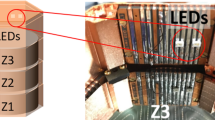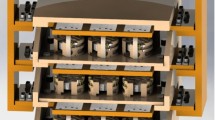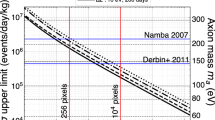Abstract
The TORIO-229 experiment aims for a direct model-independent determination of the transition energy of \(^\mathrm {229m}\)Th produced in \(^\mathrm {233}\)U alpha decay. This knowledge will be of interest for the development of a scientific clock exploiting the thorium isomeric state, which would be able to significantly surpass the precision of the presently best clocks. As a detector for the isomeric transition, it is planned to use an array of fast transition-edge sensors (TESs) which demonstrated to be feasible in our previous work where the Ir/Au TES prototype demonstrated \(4.6\pm 1.7\) µs rise time, \(5.8\pm 2.1\) µs fall time and \(0.789\pm 0.023\) eV energy resolution and signal-to-noise ratio of \(\sim\)10 with one-photon (2.824 eV) signal, satisfying the experimental requirements. Such a microcalorimeter will allow to register the transition in every possible channel in the energy range from 3 to 50 eV and with a lifetime of > 5 µs. To have a full characterization of a single TES for the final detector array design, its thermal conductance has to be measured. In this contribution, we report on a test measurement of thermal coupling of a TORIO-229 prototype-like iridium-gold TES.
Similar content being viewed by others
Avoid common mistakes on your manuscript.
1 Introduction
Up-to-date, \(^\mathrm {229m}\)Th nuclear isomeric state is the only realistic candidate for a nuclear clock [1]. Development of such a clock could allow to surpass the contemporary atomic clock precision by up to two orders of magnitude [2, 3]. This goal requires a precise knowledge of the energy and lifetime of the \(^\mathrm {229m}\)Th state. The recent direct measurement of the transition energy of the isomeric state using spectrometry of the internal conversion (IC) electrons emitted in flight during the decay of neutral \(^\mathrm {229m}\)Th atoms, set the value to \(8.28 \pm 0.03(\mathrm {stat.}) \pm 0.16(\mathrm {syst.})\) eV [4], however, this method relies on theoretical input for the excited final states of \(^\mathrm {229m}\)Th atoms. Therefore, a calorimetric measurement, free of this systematics, would be an important independent confirmation of the result. This approach will be realized in TORIO-229 experiment which is designed to register the emerging \(\alpha\)-particle with a silicon-surface barrier detector with \(^{233}\)U deposited on it, see Fig. 1 (a), while the recoiling \(^\mathrm {229m}\)Th ion will implant itself by its up to 84 keV kinetic energy into a transition-edge sensor (TES), producing the primary signal in the microcalorimeter. The IC decay channel with its \(\sim\) 7 µs lifetime [6] will be allowed for the atom neutralized in the metallic bulk of the detector and will dominate over the rare radiative channel with its long (\(\sim 10^4\) s) lifetime [7, 8]. The energy of the consequent transition in \(^\mathrm {229}\)Th will be fully absorbed by the TES producing an observable current signal which can be read-out by a SQUID (Superconducting Quantum Interference Device).
a Scheme of the TORIO-229 experimental setup. From [5]. b Schematic illustration of thermal coupling components of the TES. \(G^{\mathrm {Ir/Au} \hbox {-}\mathrm {Nb}}_\mathrm {A}\) and \(G^{\mathrm {Ir/Au} \hbox {-}\mathrm {Nb}}_\mathrm {K}\) are correspondingly Andreev and Kapitza couplings of the TES Ir/Au bilayer to the niobium wiring; \(G^{\mathrm {Ir}/\mathrm {Au}}_{\mathrm {e} \hbox {-}\mathrm {p}}\) is the thermal conductance coupling between electron and phonon systems of Ir/Au film, considered as a whole metal volume; \(G^\mathrm {Nb}_{\mathrm {e} \hbox {-}\mathrm {p}}\) is the electron–phonon conductance of the niobium wiring; \(G^{\mathrm {Ir/Au} \hbox {-}\mathrm {Si}}_\mathrm {K}\) and \(G^{\mathrm {Nb} \hbox {-}\mathrm {Si}}_\mathrm {K}\) are iridium and niobium Kapitza couplings to the silicon, respectively
The proposed experiment requires a detector operating in 1–10 eV range with a sub-eV resolution. The detector has as well to be fast for a good separation between the primary and the secondary signals produced by the absorption of the \(^\mathrm {229m}\)Th ion and its subsequent decay, respectively, i.e., having less than 7 µs fall-time \(\tau _\mathrm {fall}\) and even smaller rise-time \(\tau _\mathrm {rise}<\tau _\mathrm {fall}<7 \mathrm {\mu s}\). At the same time, the final detector has to have a large active area because of the large half-life and the consequent low activity of the \(^{233}\)U mother isotope (\(\sim 1.6\cdot 10^5\) y) and the small penetration depth of thorium ions, so the uranium source has to be in the form of a large-area thin film. To satisfy all these requirements, the detector can be built as an array of TES pixels of the total active area of \(2\cdot 10^4\) \(\mathrm {\mu m}^2\) to give a sufficient count rate to detect the \(^\mathrm {229m}\)Th decay peak with a good confidence within a few weeks of data-taking.
Previously, we fabricated a batch of 150 nm Ir + 50 nm Au prototype TESs on a silicon substrate, with a mid-point critical temperature \(T_\mathrm {c}\approx\) 111 mK, from which a 400 \(\mathrm {\mu m}^2\) detector was calibrated demonstrating a response time and an energy resolution satisfying the experimental requirements as described in [5]. The underlying physical parameter defining and limiting the detector speed is its natural thermal coupling.
In general, the total thermal conductance of such a device includes electron and phonon components of the sensitive layer and of the wiring. A thermal coupling scheme of such a TES is shown in Fig. 1b. In analogy to the considerations described in [10], in case of this TES, since at the working temperature, the niobium wiring is superconducting, Andreev reflection of electrons of Ir/Au bilayer at the transition takes place, giving a negligible contribution to the electronic thermal conductance \(G^{\mathrm {Ir/Au} \hbox {-}\mathrm {Nb}}_\mathrm {A}\). The Kapitza coupling \(G^{\mathrm {Ir/Au} \hbox {-}\mathrm {Nb}}_\mathrm {K}\) is also strongly suppressed due to the small (by design) contact areas between the wiring and the TES layers, leading to the total thermal conductance being essentially
For a TES of thermal capacity C, the effective thermal coupling \(G_\mathrm {eff}\) defines the electrothermal feedback (ETF) time constant \(\tau _\mathrm {ETF}\)
which can be determined from a measurement of the electrical signal induced in the TES by energy deposition. In a low ETF regime - with the minimal loop gain \(\mathscr {L} = \frac{\alpha \cdot P_\mathrm {bias}}{G \cdot T_\mathrm {TES}}\), where \(P_\mathrm {bias}\) is the Joule power dissipated in the TES, \(\alpha (T_\mathrm {TES}) =d\log R_\mathrm {TES} / d\log T_\mathrm {TES}\) is the logarithmic temperature sensitivity, and \(T_\mathrm {TES}\) is the temperature of the TES, the effective thermal coupling is
In this work, we examine the natural thermal conductance of the Ir/Au TES film. Because the TES volume itself works as an absorber for the low-energy IC nuclear decay, the method is based on the assumption that the energy is primarily deposited in the film’s electron gas and then released to the substrate. Therefore, a direct laser excitation of electrons in the metal bilayer simulates the actual detection process and gives out the electron-to-substrate thermal coupling.
2 Measurements and Results
A 2500 \(\mathrm {\mu m}^2\) Ir/Au TES used for the determination of the thermal conductance was fabricated in the same batch with the detector discussed in [5], and the same experimental setup was used for the below-described measurements, see Fig. 2a. The TES was mounted in the Kelvinox K25 dilution fridge on a copper holder with a Plexiglas lid. The lid has a hole microscopically aligned to the TES where an optical fiber from the 439 nm (2.824 eV) pulsed laser source (PLP-10-044, Hamamatsu Photonics K.K) with 100 ps pulse-length was fixed (providing 1 mm-wide light spot on the chip). The holder with the lid was wrapped with a copper foil to reduce the background loading due to possible stray light, leaving only a small entrance for electrical wiring.
As presented in Fig. 2b, the biasing of the TES was done using a voltage source in series with a large resistance \(R_\mathrm {L}\) to simulate a current bias. The TES with the resistance \(R_\mathrm {TES}\) depending on the TES temperature at a given operation condition \(T_\mathrm {TES}\) had in series an input coil, with a shunt resistance connected in parallel. The input coil was inductively coupled to the SQUID operated under flux-locked loop (FLL) with its feedback chain, with the gain defined as \(G_\mathrm {S}=R_\mathrm {fb}\frac{M_\mathrm {in}}{M_\mathrm {fb}}\), where \(R_\mathrm {fb}\)=100 k\(\mathrm {\Omega }\) is the SQUID feedback coil resistance, and \(\frac{M_\mathrm {in}}{M_\mathrm {fb}}\) is the ratio between the input-SQUID and the feedback-SQUID mutual inductances.
a Schematic representation of the measurement setup. The Ir/Au TES with Nb wiring (1) on a silicon chip (2) was attached to a copper holder (3). The holder was fixed on a heavy copper block (4) mounted on the mixing chamber of the cryostat with steel tubes (5). The wiring pads of the detector were bonded with aluminum wires (6) to copper pads (7) at the copper holder, separated by an insulating layer (8). Two wires (9) lead to the SQUID circuit from the copper pads. The light from the pulsed laser source outside the cryostat was delivered by the optical fiber (10) fixed into a hole of a Plexiglas lid (11) above the detector. b Schematic representation of the acquisition system. The TES (\(R_\mathrm {TES}\)) with the parasitic resistance \(R_\mathrm {par}\) in series was voltage-biased by being connected in parallel to a shunt resistance of \(R_\mathrm {sh}=(4.79 \pm 0.05)\) \(\mathrm {m \Omega }\) and receiving \(f=\) 0.1 Hz triangular voltage waveform using Keithley 3390 function generator through a load resistance of \(R_\mathrm {L}=(101 \pm 1)\) \(\mathrm {k\Omega }\). The TES current \(I_\mathrm {TES}\) was measured by reading the output voltage \(V_\mathrm {out}\) of a VTT K3B DC SQUID inductively coupled to an input coil connected in series to the TES of \(R_\mathrm {TES}\) (which depends on the device temperature \(T_\mathrm {TES}\)). The SQUID was connected to an amplification feedback circuit from Magnicon XXF-1 set [9], and the output of the circuit was filtered with a SR560 low-noise voltage amplifier, with the ultimate passband of the read-out system used for pulse acquisition being 0.3 kHz–1 MHz (while for the load curve measurements, the electronics was DC-coupled with no high-pass filter applied)
The IV-characteristic (load) curves of the TES were acquired at various thermal bath temperatures in the range between 103 mK and 112 mK, see Fig. 3a. Figure 3b shows the TES resistance 3D profile \(R_\mathrm {TES}(I_\mathrm {bias},T_\mathrm {bath})\) obtained from these measurements.
a Load curves measured for the prototype TES at different \(T_\mathrm {bath}\). b Surface plot of the TES resistance \(R_\mathrm {TES}\) as function of the bias current \(I_\mathrm {bias}\) fed to the TES voltage-bias circuit and bath temperature \(T_\mathrm {bath}\) obtained from the load curve measurements
From the linear part of the load curves at the low-bias region, the TES resistance dependence on its temperature (which at this condition is similar to the bath temperature) was obtained, which is shown in Fig. 4. The parameters of the superconducting transition were obtained by fitting these data points with the empirical formula
From the linear part of the load curves at the low bias where \(R_\mathrm {TES}\) is resistance of the TES, \(T_\mathrm {c}\simeq 111.2\) mK is the critical temperature of the TES (the mid-point of resistive transition from normal state to superconducting state), \(\Delta T\) is the parameter defining the transition width, \(R_\mathrm {TES}^\mathrm {normal}\simeq 280\) m\(\Omega\) is its normal resistance and \(R_\mathrm {par}\simeq 0.24\) m\(\Omega\) is the parasitic resistance. The corresponding logarithmic temperature sensitivity is also shown in Fig. 4. The inverse of (4) gives \(T_\mathrm {TES}(R)\) relation used as reference for TES effective temperature calculation.
To assess the thermal coupling between the film and the substrate, sets of \(\mathscr {O}(10^3)\) pulses were acquired and averaged at different working points with different DC bias and bath temperatures in order to move in the parameter space to reduce the ETF term in (2). The SQUID signal was amplified with gain 100 and filtered with band pass 300 Hz–1 MHz using the external preamplifier Stanford SR560. The corresponding signal rise and decay times were extracted by fitting the signal shapes, see Fig. 5a.
For the working point with \(T_\mathrm {bath}\)=105.63 mK and \(I_\mathrm {bias}=8.91\pm 0.3\) \(\mathrm {\mu }\)A, in which the longest decay time was observed, the resistance of the TES of (\(1.44 \pm 0.24\)) \(\mathrm {m\Omega }\) was found from the \(R_\mathrm {TES}(I_\mathrm {bias},T_\mathrm {bath})\) 3D profile of the device, shown in Fig. 3b. The signal rise time at the low-inductance limit is defined by \(R_\mathrm {TES}\) and the TES bias circuit inductance L,
from where L was estimated to be (\(2.61\pm 0.45\)) nH, which is consistent with the nominal 3 nH of the SQUID input coil with a negligible stray inductance in the circuit. Knowing the TES resistance and the bias current, the power dissipated in the TES was estimated to be \(P_\mathrm {bias}=R_\mathrm {TES} \cdot I_\mathrm {TES}^2 =R_\mathrm {TES} \cdot (I_\mathrm {bias} \frac{R_\mathrm {sh}}{R_\mathrm {sh}+R_\mathrm {TES}})^2 = 0.07\pm 0.01\) pW.
To estimate the thermal conductance, the dissipated power \(P_\mathrm {bias}=V_\mathrm {TES} \cdot I_\mathrm {TES} = (V_\mathrm {sh}-I_\mathrm {TES} \cdot R_\mathrm {par}) \cdot I_\mathrm {TES}\) as function of TES temperature obtained from the load curves at 105.08 mK and 106.09 mK of bath temperature was calculated. The derivative around the \(T_\mathrm {TES}=110.95\) mK obtained for this working point gives around 1.23 nW/K and 0.76 nW/K for the two bath temperatures, respectively, see Fig. 5b. Linear interpolation between these two values gives \(G_\mathrm {eff}\)=(0.98±0.01) nW/K at \(T_{{{\text{bath}}}} =\)105.63 mK. Estimated loop gain is \(\mathscr {L}=1.25\pm 0.18\) in this condition, and from (3) G = (0.44±0.03) nW/K.
a Measured signal from the TES and its amplification chain and its fit with signal model consisting of the exponential in time t decay and rise parts with amplitude A (modulated via \(\Theta (t-t_0)\) Heaviside step function to account for the signal start moment \(t_0\)) over a sinusoidal component from the electronic filtering with amplitude a, period \(2\pi /b\), phase shift c/b and offset d. b Power as function of TES temperature at 105.08 mK and 106.09 mK of bath temperature and corresponding linear fits around T\(_\mathrm {TES}=110.95\) mK
3 Conclusion
In this work, we made first examination of the thermal conductance of Ir/Au films of the prototype TES of the TORIO-229 detector by the direct excitation of TES electron gas with a laser pulse in a representative configuration similar to the experimental one. Since niobium wires do not contribute to the thermal conductance of TES, for the final TES array wiring can be optimized in the design regardless from the conductance considerations as soon as the overlap with TES remains small. In the upcoming tests, the procedure will be improved by taking load curve data at more temperature values across the superconducting transition region for an accurate adjustment of the working point with \(\alpha \cdot P_\mathrm {bias}\) minimization to reach the condition where the effective thermal conductance approaches G. To confirm reliability of the results, TESs of various surface areas with otherwise similar structural parameters will be tested in the same manner to check any correlation between thermal conductance and the TES surface and volume. Once verified, the procedure can be applied to the new prototypes and eventually to the design and test of the final detector array.
Data Availability
The data supporting the findings of this study are available from the authors on request.
References
P.G. Thirolf, B. Seiferle, L. von der Wense, The 229-thorium isomer: doorway to the road from the atomic clock to the nuclear clock. J. Phys. B At. Mol. Opt. Phys. 52(203001), 25 (2019). https://doi.org/10.1088/1361-6455/ab29b8
K. Gao, (2020) The \(^{40}\)Ca\(^{+}\) ion optical clock. Natl. Sci. Rev. 7(12), 1799–1801 (2020). https://doi.org/10.1093/nsr/nwaa119
C.J. Campbell et al., Single-ion nuclear clock for metrology at the 19th decimal place. Phys. Rev. Lett. 108, 120802 (2012). https://doi.org/10.1103/PhysRevLett.108.120802
B. Seiferle et al., Energy of the \(^{229}\)Th nuclear clock transition. Nature 573, 243–246 (2019). https://doi.org/10.1038/s41586-019-1533-4
M. Fedkevych et al., Direct search for low energy nuclear isomeric transition of Th-229m with TES detector. IEEE Trans. Appl. Supercond. 31(5), 1–4 (2021). https://doi.org/10.1109/TASC.2021.3063328
B. Seiferle, L. von der Wense, P.G. Thirolf, Lifetime measurement of the \(^{229}\)Th nuclear isomer. Phys. Rev. Lett. 118, 042501 (2017). https://doi.org/10.1103/PhysRevLett.118.042501
N. Minkov, A. Pàlffy, Reduced transition probabilities for the gamma decay of the 7.8 eV isomer in \(^{229}\)Th. Phys. Rev. Lett. 118, 212501 (2017). https://doi.org/10.1103/PhysRevLett.118.212501
E. V. Tkalya et al. Radiative lifetime and energy of the low-energy isomeric level in \(^{229}\)Th. Phys. Rev. C 92, 054324, 25 November 2015; Erratum Phys. Rev. C 95, 039902 (2017) https://doi.org/10.1103/PhysRevC.92.054324, https://doi.org/10.1103/PhysRevC.95.039902
Magnicon GmbH, http://www.magnicon.com/squid-electronics/xxf-1. Last accessed: 18.10.2021
D. Bagliani et al., Ir TES electron-phonon thermal conductance and single photon detection. J. Low. Temp. Phys. 151, 234–238 (2008). https://doi.org/10.1007/s10909-007-9641-1
Acknowledgements
The authors would like to thank L. Parodi and S. Burioli for supporting the laboratory low temperature activities for this experiment.
Funding
Open access funding provided by Università degli Studi di Genova within the CRUI-CARE Agreement.
Author information
Authors and Affiliations
Corresponding author
Additional information
Publisher's Note
Springer Nature remains neutral with regard to jurisdictional claims in published maps and institutional affiliations.
Rights and permissions
Open Access This article is licensed under a Creative Commons Attribution 4.0 International License, which permits use, sharing, adaptation, distribution and reproduction in any medium or format, as long as you give appropriate credit to the original author(s) and the source, provide a link to the Creative Commons licence, and indicate if changes were made. The images or other third party material in this article are included in the article's Creative Commons licence, unless indicated otherwise in a credit line to the material. If material is not included in the article's Creative Commons licence and your intended use is not permitted by statutory regulation or exceeds the permitted use, you will need to obtain permission directly from the copyright holder. To view a copy of this licence, visit http://creativecommons.org/licenses/by/4.0/.
About this article
Cite this article
Fedkevych, M., Biasotti, M., De Gerone, M. et al. An Examination of Thermal Coupling of an Ir/Au TES for TORIO-229 Experiment. J Low Temp Phys 209, 473–481 (2022). https://doi.org/10.1007/s10909-022-02901-x
Received:
Accepted:
Published:
Issue Date:
DOI: https://doi.org/10.1007/s10909-022-02901-x









